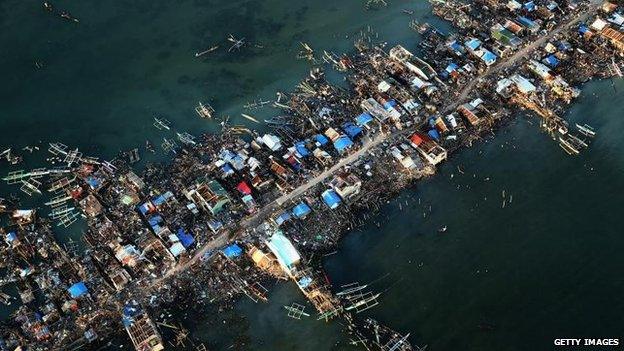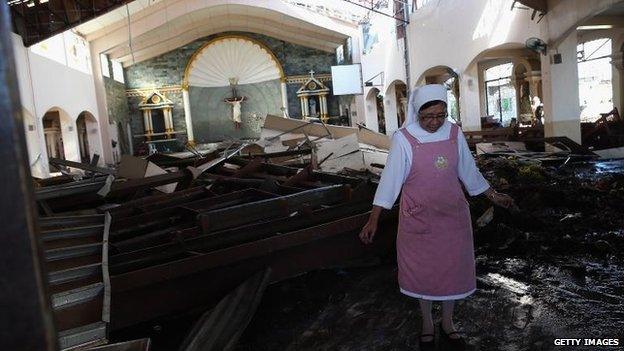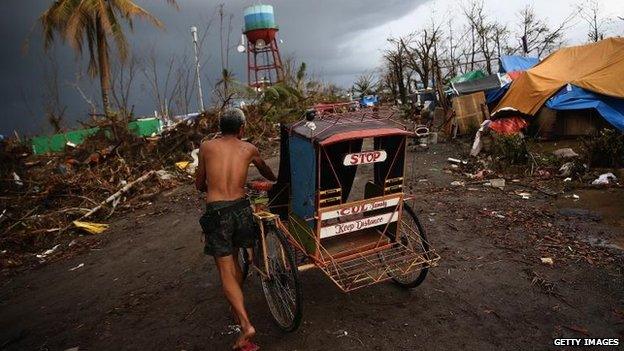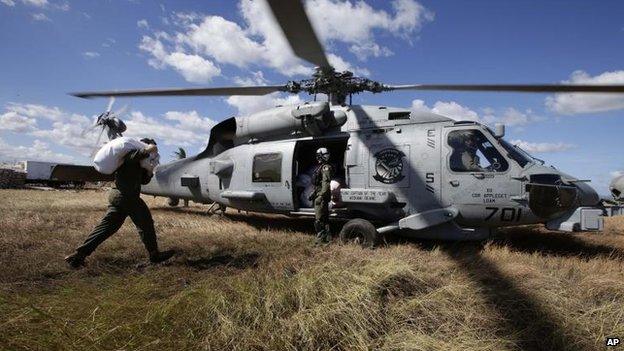Typhoon Haiyan: Philippines death toll up as aid arrives
- Published
The BBC's Andrew Harding: "The very first encounter between storm and land. Not much of a contest"
The number of people in the Philippines confirmed dead from Typhoon Haiyan now stands at 3,631, officials say.
UN and local agencies have issued conflicting tolls, and the final figure is likely to rise still higher.
One week after the storm, food and supplies are now beginning to reach survivors, but aid agencies say the logistics of distribution are enormous.
The Philippine government has defended its response to the disaster, one of the strongest storms ever on land.
The BBC's Rupert Wingfield-Hayes: "There has been a dramatic change today"
In its latest update,, external the National Disaster Risk Reduction and Management Council said 3,631 people were confirmed dead as of 20:00 local time (12:00 GMT). The number of injured stood at 12,487, while 1,187 people are officially listed as missing.
In all, the council said more than nine million people had been affected, including 1,871,321 who had been displaced.
The UN put the number of dead at 4,460. Officials said it was likely more bodies would be found as aid teams reached outlying areas.
'Desperate shortage'
Helicopters from a US aircraft carrier have been transporting supplies to the devastated town of Guiuan on the Pacific coast - the first to take the full force of the typhoon.
The carrier, USS George Washington, is expanding search-and-rescue operations and providing a platform for helicopters to move supplies.
Pallets loaded with food and water have been taken from the aircraft carrier to Tacloban, the capital of badly hit Leyte province, and Guiuan.
However, the Philippine government says efforts to deliver aid are being hampered by a desperate shortage of trucks.
"In a situation like this, nothing is fast enough," said Interior Secretary Mar Roxas. "The need is massive, the need is immediate, and you can't reach everyone."

Aid is now getting through to some of the areas badly hit by the storm

St Joseph Church in the city of Tacloban was among the buildings damaged by Typhoon Haiyan

But with many roads and communication links destroyed, it has been difficult to make a full assessment of the impact

Helicopters from the aircraft carrier USS George Washington are now helping with the aid effort
The emergency services themselves have been hard-hit: in the city of Tacloban, barely a quarter of the police force reported for work this week, BBC correspondents say.
The charity Medecins Sans Frontieres said workers who had visited Guiuan, in eastern Samar, described the situation faced by the 45,000 people there as "bleak".
Many of the dozens of bodies lying in the open since Typhoon Haiyan struck are now being cleared from the streets and buried.
Despite the relief effort, thousands of survivors continued to line up at Tacloban's airport on Thursday trying to leave the city.
Many countries have pledged help in the shape of financial aid, relief supplies or emergency teams.
The UK government is sending the aircraft carrier HMS Illustrious, more than £20m ($32m) in aid, a team of medical experts and an RAF transport aircraft.
China - which is engaged in a territorial dispute with the Philippines - is sending 10m yuan ($1.6m; £1m) in relief goods.
Its initial pledge of $200,000 (£120,000) from the government and Chinese Red Cross combined drew criticism in US media, but was also condemned by some Chinese internet users as excessive.